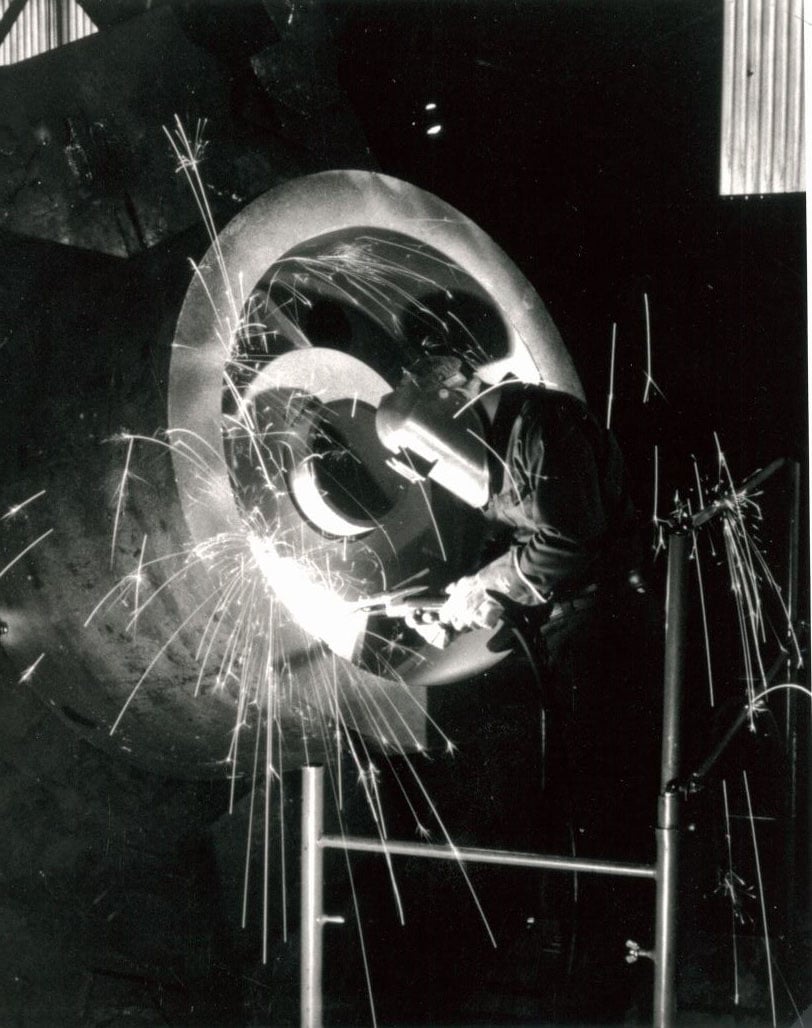
Welding is a ubiquitous method of metalworking that joins two pieces of metal together to form a strong bond. But what exactly happens when the two metals join together? By definition, welding joins two pieces of metal by fusion. In order to properly fuse together, the base metal must melt and flow together. Older welding methods would employ an oxyfuel blowtorch to heat pieces of metal until the base metals reached melting temperature, but newer methods now use an electric arc to generate the heat necessary to melt the metal. The arc is created when an electric charge is passed from an electrode to the workpieces. The electrode is usually consumable and charged either negatively or positively depending on the desired character of the weld. A proper weld often creates a bond between workpieces that is stronger than the original strength of the workpieces themselves.
There are many different interfaces that use this basic premise to achieve a weld. The most widely used method is shielded metal arc welding (SMAW), more commonly known as stick welding. This method involves using a consumable electrode in the form of a stick that is covered in flux to create an arc that melts the filler and joins the workpieces. Gas Metal Arc Welding (GMAW), known colloquially as MIG welding, is a method that uses a consumable wire as the electrode that is fed automatically through a gun which simultaneously dispenses argon gas as a shielding agent. Submerged Arc Welding (SAW) involves welding a joint using an electric arc smothered under a bed of flux. A mostly automatic process, filler wire is slowly fed along the joint beneath the flux. This method yields high quality welds because of the flux coating the arc and wire; there is no risk of splatter due to the great presence of flux. Gas tungsten arc welding (GTAW), also known as TIG welding, is the most precise and time consuming. Wire is fed by hand carefully into an arc generated by a non-consumable tungsten electrode housed in an argon dispensing gun, similar to MIG. The tungsten alloy electrode will not melt under the high heat of the arc which facilitates the precision of a handfed wire. This method requires a high level of skill and is applied in special circumstances.
The art of welding comes from a welder’s personal method of welding. Many variables affect the characteristic of the weld at the same time, which is why welding engineers have procedure qualification records (PQRs) to ensure a sound weld in specific situations. Many welders take a unique approach to balancing these variables, giving a well-trained welder a distinct method all their own. Material, thickness, type of joint, and angle of weld are all variables that need to be considered. At the same time, heat must be evenly kept between the two workpieces, else the weld will be inconsistent. A welder with a positive record can successfully weld in a wide variety of situations, and a mastery of these situations allows for the development of a personal method or style.

A weld is extremely sensitive to atmospheric contamination. If a weld is made without proper shielding, it can result in a porous or weak weld. Flux is used in shielded metal arc welding to coat the electrode and in submerged arc welding to cover the weld area. When flux is consumed, it creates carbon dioxide and slag. The carbon dioxide acts as a shielding gas and protects the weld, while the slag remains as a solid byproduct of the melted flux. The slag must be removed for quality assurance and aesthetic consistency. In MIG and TIG welding, argon gas is used as the shielding agent. Argon is a non-reactive gas that protects well against contamination, and is supplied by the weld gun in these applications. TIG welding often requires high precision, and in some applications, the workpieces are placed in a small chamber that is filled with argon gas to provide a “clean room” environment to prevent any possible contamination.
Welding is an industry characterized by quality workmanship and continuous qualification. Certification can only be given if a welder can consistently produce quality work, and this certification is subject to how often a welder practices his or her craft. Projects often require that the welders are certified to a specific code. This ensures that only approved welders contribute to a project, an important specification to demanding customers including federal and local governments. Because of the need to stay certified, the name of the game in welding truly is “use it or lose it.”
Welding is a complex process that requires balancing many variables to create a structurally sound product. There are many different methods to choose from, and within each method are a myriad of different styles to utilize for a specific application. As an essential tool in a fabricators toolbox, understanding the process of welding is absolutely paramount.

 From the Floor - Coal Mining Cable Reel
From the Floor - Coal Mining Cable Reel